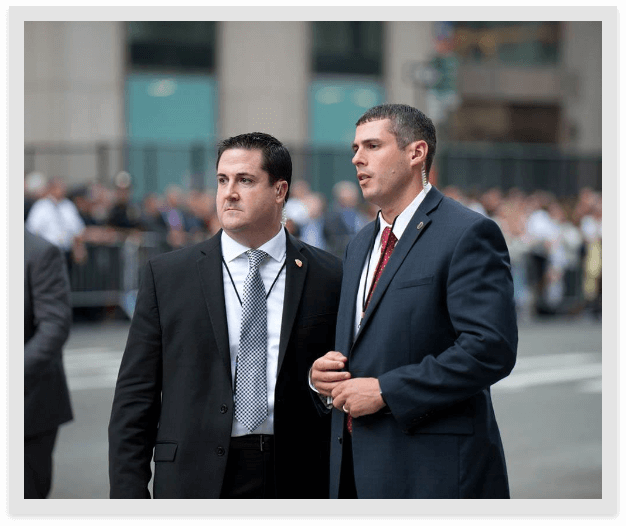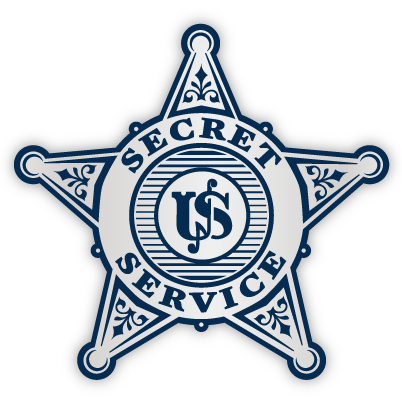Career Path
Frequent travel and reassignments to a variety of duty stations (occasionally including liaison assignments in foreign countries), are some of the unique opportunities that await a special agent.
A typical special agent career path, depending upon performance and promotions that affect individual assignments, begins with the first three to five years on the job assigned to a field office. Newly-appointed agents may be assigned to field offices anywhere in the United States.
After their field experience, agents are usually transferred to a protective assignment where they will stay for three to five years. Following their protective assignment, many agents return to the field or transfer to a headquarters office, a training office or other Washington, D.C.-based assignment.

During their careers, agents also have the opportunity to work overseas in one of the agency's international field offices. This typically requires foreign language training to ensure language proficiency* when working alongside the agency's foreign law enforcement counterparts.
* A one-time recruitment bonus (25% of basic annual pay) may be paid to newly-hired special agents who are identified as having a foreign language skill and can test at the S-3 level. This level requires that the applicant has the ability to speak the language with sufficient structural accuracy and vocabulary to participate effectively in most formal and informal conversations on practical, social and professional topics. The recruitment bonus must be approved prior to the applicant’s first day of employment and will be paid as a lump sum upon successful completion of all required training and graduation from the U.S. Secret Service training center. The actual payment will depend on the availability of funds.
Special Agent Career Phases and Assignments
A special agent typically will progress through phases three during their Secret Service career:
- Phase 1 (Career entry/Field Office assignment)
- Phase 2 (Protective assignment)
- Phase 3 (Post-protective field, protection, or headquarters assignment)
Phase 1 (Career Entry/Field Office Assignment)

All special agents begin their careers in Phase 1.
All special agents entering the Secret Service will be assigned to a field office(s) for a minimum of three years prior to being reassigned to a permanent protection assignment. *
*Special agents under a specialized commitment (e. g., ECSAP; Polygraph) are not eligible for assignment to a permanent protective division until their assignments are completed, but they may be eligible for reassignment to another investigative office where they may complete their respective commitments.
Currently, it is expected that no special agent will be reassigned to Phase 2 assignments until he/she has completed approximately four years in Phase 1. However, special agents with a preference for a Phase 2 assignment to the Special Operations Division's (SOD) Counter-Assault Team (CAT), Protective Intelligence and Assessment Division (PID), or Former President's Division (existing or at start-up of the new division) may be reassigned to Phase 2 after only three years in Phase 1.
Phase 2 (Protective Assignment)
A special agent begins Phase 2 once he/she is reassigned to a permanent protective division. Special agents assigned to permanent protection will serve in one or more of the following offices:
- Office of Protective Operations:
- Presidential Protective Division (PPD)
- Vice Presidential Protective Division (VPD)
- Special Operations Division (SOD)/Counter Assault Team (CAT)
- Office of Strategic Intelligence and Information - Protective Intelligence and Assessment Division (PID)
With the exceptions noted below*, the above assignments will be:
- Located in the Washington, D. C. metropolitan area, and;
- Last for a minimum of six years from the date the employee begins his/her assignment.

Upon completion of three years on CAT, a special agent may (based on availability) elect reassignment to PPD, VPD, or PID to complete the protection requirement (i.e., an additional three years).
Upon completion of four years on any of the above assignments, the special agent may elect to:
- Continue his/her assignment to PPD/VPD/SOD/PID for two additional years (for a total of six years);
- Or, transfer (if available) to a Former President's Division, PPD, VPD or PID for a minimum of four years for a total of eight years) in a Phase 2 assignment.
Any reassignment from Phase 1 directly to a Former President's Division (existing or at start-up of the new division, based on the needs of the Secret Service) which is outside the DC area will be a six-year assignment.
Any request to deviate from these guidelines which could result in extending a special agent beyond six or eight years, as listed above, will be addressed to the Special Agent Review Committee (SARC) and handled on a case-by-case basis.
Phase 3 (Post-Protective Field Protection or Headquarters Assignment)
A special agent begins Phase 3 once they have been reassigned from their permanent protective (Phase 2) assignment or has chosen and been approved for an available "opt-in" on a permanent protective assignment after the completion of the Phase 2 protection assignment six or eight-year minimum total time period.

During Phase 3, special agents have several availability-based assignment/reassignment options:
- Opt-in via yearly election to their current protective assignment (based on availability and operational needs) for an additional year.
- Reassignment to a permanent protective assignment other than their current protection assignment PPD, VPD, CAT, PID, or a Former President's Division).
- Reassignment to a Washington, D.C.-based headquarters or training assignment (e. g., Counter Surveillance Division (CSD); Criminal Investigative Division (CID) — Critical Systems Protection Program (CSP); Hazardous Agent Mitigation Medical Emergency Response (HAMMER); Technical Security Division (TSD); or the James J. Rowley Training Center (JJRTC).
- Reassignment to a field office. *
*Except those special agents assigned after September 1, 2015, to a non-Washington, DC-based protective assignment (e.g., Former President's Division), and have never been permanently assigned to the Washington, D.C. area, will not have the immediate option of returning to a field office assignment other than the Washington or Baltimore Field Offices.
In Phase 3, special agents will have the opportunity for specialization, training, and development in an area of their interest. Possible areas of specialization include the Electronic Crimes Special Agent Program, Polygraph, Legal, Training, Congressional and Public Affairs, Logistics Management, Technical Security, and HAMMER.
Our Phase 3 special agents will also have the opportunity for unique assignments such as foreign field office locations, as well as to assignments outside the Secret Service, including the Department of Homeland Security, intelligence agencies and programs, the United States Attorney's Office (special agent/attorneys only), and Congressional staff positions.
Special agents who are transitioning from a Phase 2 Washington D.C. assignment will have priority eligibility for Phase 3 headquarters, field, and protective assignments.
All assignments to Phase 3 will be for a minimum of three years, with the following exception:
Phase 3 special agents who are assigned to the Washington Field Office or Baltimore Field Office will be given the option to leave the Washington Field Office or Baltimore Field Office after a two-year period. Special agents who chose not to exercise the option to leave the Washington Field Office or Baltimore Field Office will receive one (1) additional opportunity to leave at the four (4) year mark.
For all non-field office Phase 3 reassignments, once the minimum three-year period is completed, the Phase 3 special agent may elect yearly to "opt-in" (remain) in the current assignment for an additional year. This option requires the special agent to make this request via SSF 4028A, “Special Agent Assignment Opt-In Election for Non-Field Office Assignments," through his/her division chief/SAIC to the respective directorate head (e.g., Assistant Director, Chief), and requires approval by both. For all domestic field office assignments after the minimum requirement, a field office assignment may be continued for an indefinite timeframe and requires no request for opt-in after the initial period in that office. (See provisions regarding foreign assignments below).
Phase 3 special agents seeking reassignment may do so by applying to an open job opportunity announcement (JOA). Phase 3 special agents may apply to a JOA at any time after they have completed their three years minimum assignment time or as otherwise stated in the JOA. Phase 3 special agents who have requested an opt-in may also apply to a JOA at any point in the opt-in period. However, prior to submitting an application, a special agent should refer to the particular JOA they are interested in for specific eligibility requirements to ensure they meet the minimum qualifications.
Phase 3 non-field office special agents who have completed their minimum assignment period and who have either (1) not requested an opt-in or, (2) have been denied an opt-in, will be returned to the SARC for reassignment to a subsequent Phase 3 assignment.
The three-year minimum commitment time to a Phase 3 assignment will in no way restrict a special agent's ability to compete, bid, or be selected for promotion to the GS -14 level.


